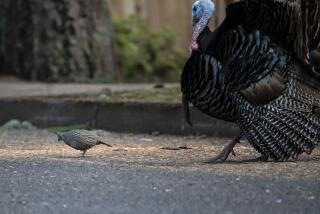Noisy Peacocks Ruffle Feathers
Besieged Rancho Palos Verdes officials have decided to fly the pied piper of peacocks from Iowa to give angry residents advice on how to live with screaming, flower-eating and ever-multiplying peafowl.
Nearby Palos Verdes Estates officials are also contending with residents upset about peacocks and peahens. But their efforts to round up birds and ship them to better homes have been met by angry confrontations between police and bird lovers determined to prevent the trappings.
The peacock battles on the Palos Verdes Peninsula have exploded again.
Neighbors who leave cat food out for the peacocks are pitted against neighbors who drive the birds away with water guns and air rifles. And law enforcement and city officials are caught in the middle. “This is the most polarizing issue in the community,” said Tim Brown, Palos Verdes Estates chief of police, who said his tiny city of 15,000 residents gets up to 10 calls a day about the birds.
“You have people that love them and people that hate them. You can’t cut the baby in half,” said Lee Byrd, mayor of the 47,000-resident Rancho Palos Verdes. “I don’t see any way to make everyone happy.”
Legend has it that the first peacocks were brought to the peninsula in 1923, as a gift from someone who thought the place was too quiet. Although no one knows how many birds roam the four upscale cities of Rolling Hills, Rolling Hills Estates, Palos Verdes Estates and Rancho Palos Verdes, almost everyone agrees that their numbers are increasing.
Squabbles over the peacocks erupted in the late ‘80s and early ‘90s. That prompted city officials in Palos Verdes Estates to relocate excess birds. In Rolling Hills Estates, city officials sought to teach residents how to get along with them.
Those efforts do not appear to have worked.
In recent years, Rancho Palos Verdes residents charge, the exotic screechers have migrated from less populated areas into neighborhoods where houses are closer together. They are drawn by cat food and birdseed some residents leave out, as well as by a delicious array of well-kept gardens. During the mating season, males become very aggressive, and when they see their reflections in a brand new SUV or a plate glass window, they’ll peck at it unmercifully, under the impression that it’s a competing bird.
Thanks to the peafowl, the peninsula is certainly not quiet anymore.
“It’s unbelievable. It’s like a child in agony,” said Barbara Gleghorn of the shrieks. Gleghorn purchased a set of water guns to drive the peafowl away. She has given up on having a garden because the flowers are quickly decimated by the ravenous birds. And don’t even get her started about picking up peacock droppings.
“Between the noise, the droppings and the destruction to the landscape, the flock needs to be thinned out and relocated,” said Rancho Palos Verdes resident Barbara Arbuthnot, who paid $12,000 for double-paned windows in her house to muffle peacock sounds.
While they agree the population has gotten too large, some peacock-loving residents view attempts to eradicate the birds as a move to transform the area into just another suburb.
“Dogs and cats will be next, and then they’ll turn our village into a modern city so they don’t have to drive far to work or shop,” Frica Stuart wrote to Rancho Palos Verdes City Council members.
Bird-loving residents’ solution for neighbors who complain about peacocks: move.
“Perhaps they should have bought in the city, if they’re not used to wildlife,” said Kathy Snell, who nurses orphaned peafowl chicks into adulthood and then releases them back into the neighborhood. Snell says the birds kill rattlesnakes and mice and sound a warning at earthquakes and fires.
But residents awakened nightly by the mating screeches of peacocks say they don’t want to change the community. They just want to get some sleep.
Police are accustomed to panicked midnight phone calls from new residents reporting that someone is being tortured or beaten nearby. Usually it’s just the peacocks, who have a distinctive cry of “elp elp,” said Brown, the police chief.
In Palos Verdes Estates, Brown said his officers will continue trying to locate good homes--far away from the peninsula--for the peacocks. So far this year, they’ve relocated only eight.
“It’s a no-win situation from the city’s point of view,” he said. “There are people in the community who love them and feed them, and then there are people right next door who hate them. They’re here. They’re part of our history. We’ll do what we can to try and maintain peace between the two sides.”
In Rancho Palos Verdes, city officials voted on July 18 to spend $5,000 to fly in Dennis Fett, an Iowa farmer and one of the country’s few consultants on peacock behavior. Fett, who in 1992 tried to teach Rolling Hills Estates residents how to live with their flocks, said his first job will be figuring out how many peacocks are in Rancho Palos Verdes.
He will also teach residents how to keep their feathered neighbors out of their yards.
But many say Fett’s solutions will never work.
“His recommendations are basically placing restrictions on us,” said Arbuthnot. “I have followed some of his instructions. They don’t work. He told me they don’t like marigolds, so I planted marigolds. By the time the peacocks figured out that they didn’t like them, they’d picked them all.”
In letters and statements to city officials, some residents have called for the peacocks to be euthanized. Others want an ordinance to prevent their neighbors from feeding them. One resident has even proposed slipping bird birth control into seeds and feeding it to the peahens. Many also offered their yards for city officials to lay traps to catch the peafowl.
Local restaurateurs take note: More than one resident has proposed a delicacy they’d like to see on every peninsula menu. Peafowl.
More to Read
Sign up for Essential California
The most important California stories and recommendations in your inbox every morning.
You may occasionally receive promotional content from the Los Angeles Times.










